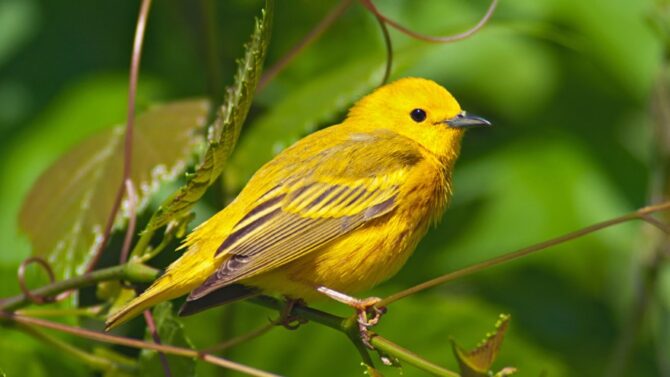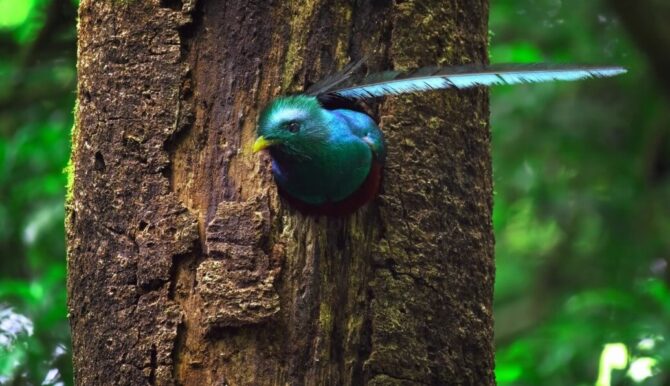Birds with bright colors are very beautiful creatures and the delight of birdwatchers.
These different species occur on most continents in the world, and you can find them in the United States!
Amongst brightly colored birds are yellow species, which often represent happiness. Examples of yellow birds include different types of warblers, goldfinches, meadowlarks, and many others.
We’ve compiled a list of 31 beautiful birds that are yellow for your education and entertainment.
Beautiful Types of Yellow Birds
1. American Goldfinch
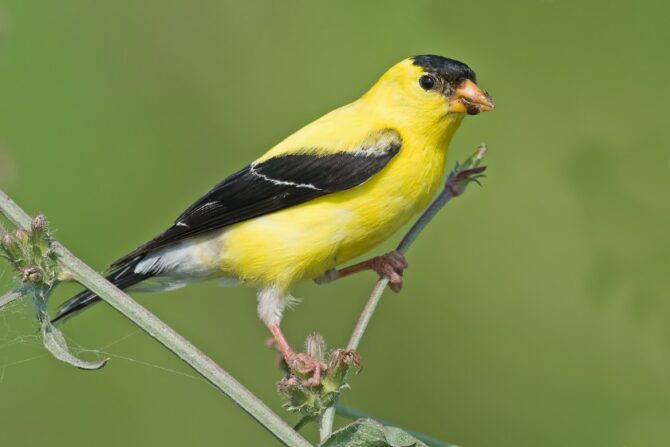
- Scientific Name: Spinus Tristus
- Length: 3.9 to 4.7 inches
- Weight: 0.4 to 0.7 ounces
- Habitat: Fields, meadows, gardens
- Where Found: North America
- Conservation Status: Least Concern
The American goldfinch belongs to the finch family, and it is a native of North America.
This small yellow bird is often found in open spaces like fields, meadows, gardens, and even roadsides.
You can easily see this bird while going about your day. It is migratory, though, moving from one part of North America to the other when the weather changes.
The male and female display differences in color, an act termed as sexual dichromatism.
Males are yellow during the summer but become olive by winter. By contrast, the female is yellow-brown and only takes on a brighter shade during the winter.
As many would expect from a bird this size, the American goldfinch is a granivore and very social.
2. Wilson’s Warbler
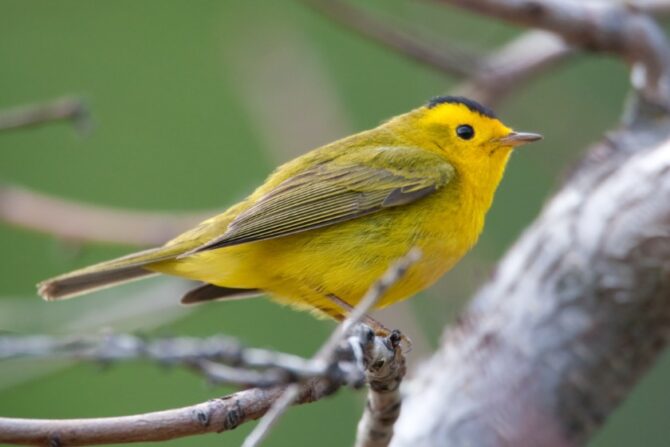
- Scientific Name: Cardellina pusilla
- Length: 3.9 to 4.7 inches
- Weight: 0.2 to 0.3 ounces
- Habitat: woodlands, forests
- Where Found: Americas
- Conservation Status: Least Concern
The Wilson’s warbler is from the family of New World Warblers known as the Parulidae.
These birds can only be found in the New World (the Americas), and the Wilson’s warbler is not an exception.
It occurs in countries like Canada, the United States, and Mexico. Its preferred habitats include woodlands and forests.
This bird has a green back, but the underneath is colored yellow. Both colors combine to give it a yellowish-green plumage.
Males come with a black crown patch which can sometimes be absent in females.
As an insectivore, Wilson’s warbler feeds on beetles, caterpillars, bees, and a couple of other insects.
3. Yellow-Rumped Warbler
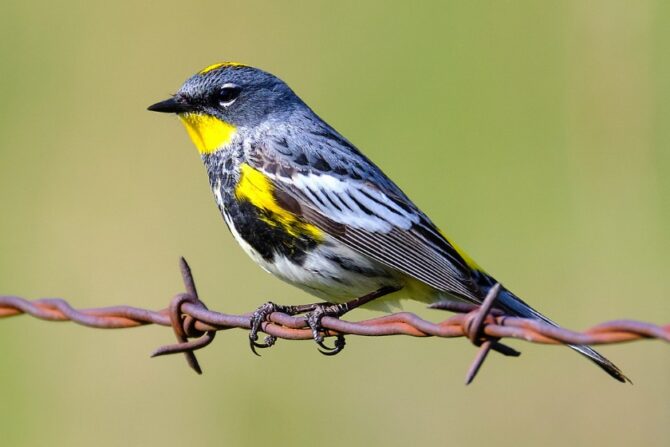
- Scientific Name: Setophaga coronata
- Length: 5.5 inches
- Weight: 0.3 to 0.4 ounces
- Habitat: Evergreen forest and edges
- Where Found: North America
- Conservation Status: Least Concern
The yellow-rumped warbler is widespread across North America and gets into the central parts when migrating during winter.
It inhabits coniferous or mixed coniferous-deciduous forests.
There are four subspecies which are the eastern myrtle warbler, Audubon’s warbler, the Mexican black-fronted warbler, and the Guatemalan Goldman’s warbler.
Appearances differ among these subspecies, but all of them have the yellow rump from which they get their name.
Other colors you’d find on this bird include black, gray, and brown.
This bird is primarily an insectivore, but the diet can vary according to subspecies. The myrtle warbler can eat fruits if it doesn’t find insects.
4. American Yellow Warbler
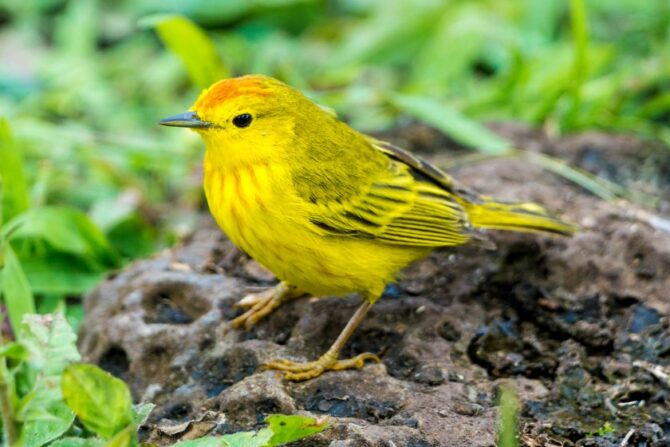
- Scientific Name: Setophaga petechia
- Length: 3.9 to 7.1 inches
- Weight: 0.25 to 0.88 ounces
- Habitat: Bushes, swamps, edges, streams, gardens
- Where Found: Americas
- Conservation Status: Least Concern
The American yellow warbler is part of the Setophaga family, like the warblers we’ve mentioned.
It is the most widespread warbler, going from North America down to the Central and the South.
It also inhabits a variety of habitats like streams, gardens, bushes, swamps, and edges.
The name already alludes to this bird’s coloration, but to be more accurate, the yellow warbler is yellowish green, especially on the upper side. The belly is usually a dull yellow.
This bird feeds primarily on caterpillars, but it isn’t the only part of its diet. It also eats wasps, mayflies, moths, beetles, mosquitoes, and others.
5. Common Yellowthroat
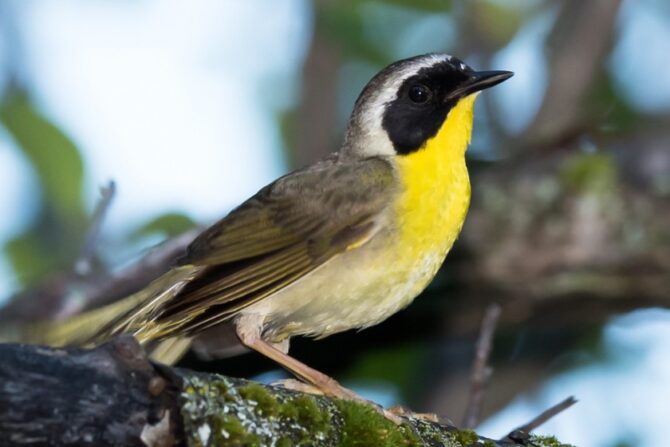
- Scientific Name: Geothylpis trichas
- Length: 4.3 to 5.1 inches
- Weight: 0.3 ounces
- Habitat: Marshes, wet thickets, edges, swamps
- Where Found: North America
- Conservation Status: Least Concern
The common yellowthroat is also known as the yellow bandit, and it is a New World Warbler—though it doesn’t bear the name.
This bird occurs mainly in North America, going from Canada to Mexico.
You may not see it in South America or even Central. Preferred habitats include marshes and dense vegetation.
All common yellowthroat individuals have an identifying feature, the yellow throat, just as the name shows.
Other than that, it is colored olive at the back, wings, and tails with white on the belly.
Males come with a black face mask, and the larger the mask, the more attractive males are to females.
6. Evening Grosbeak
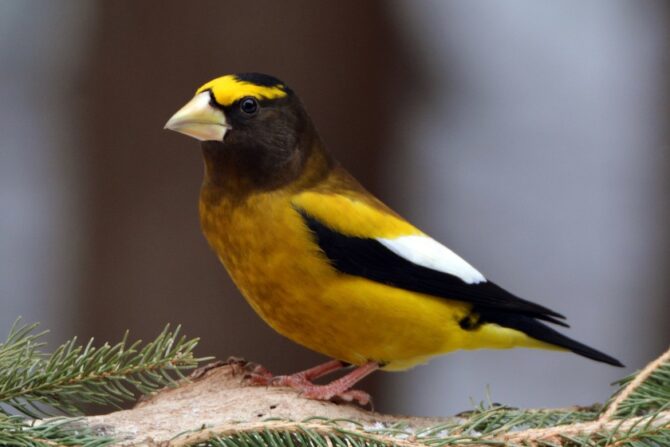
- Scientific Name: Hesperiphona vespertina
- Length: 6.3 to 8.7 inches
- Weight: 2.07 to 2.1 ounces
- Habitat: Coniferous and mixed forests
- Where Found: North America
- Conservation Status: Vulnerable
The evening grosbeak belongs to the finch family Fringillidae, and it belongs to North America, specifically in countries like Canada, the United States, and Mexico.
There are a few found in the British Isles, but it is regarded as a vagrant species there.1
Males and females have different colors, and only the males are predominantly yellow.
Females come with an olive green plumage, grey underparts, and white patches on the wings.
The males also have white patches on the wings, and their heads are brown.
7. Yellow-breasted Chat
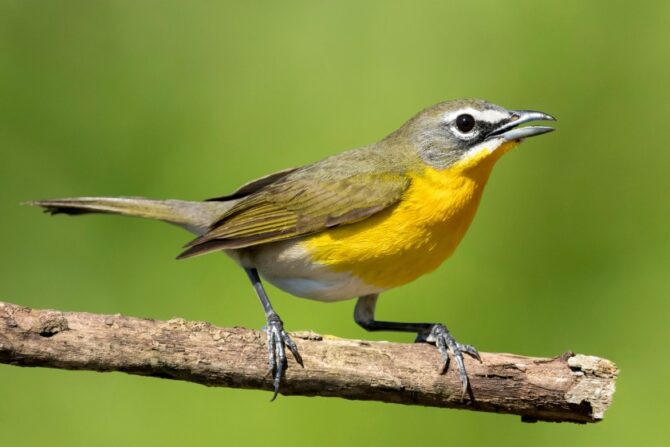
- Scientific Name: Icteria virens
- Length: 6.7 to 7.5 inches
- Weight: 0.71 to 1.19 ounces
- Habitat: Farmlands
- Where Found: North America
- Conservation Status: Least Concern
The yellow-breasted chat is in the family Icteriidae where it remains the sole member.
It used to be part of the New World Warbler, but that soon changed after it got reclassified.
The yellow-breasted chat is found more in North America, staying in countries like Canada and Mexico.
This bird is larger than most of the ones we’ve seen on this list. It is termed a songbird as it vocalizes in rhythm, which is singing.
The upper parts is colored grey, but its lower region is a lemon yellow.
The yellow-breasted chat sings as a form of communication to get a mate and to establish territories.
8. Nashville Warbler

- Scientific Name: Leitholypis ruficapilla
- Length: 4.3 to 5.1 inches
- Weight: 0.2 to 0.5 ounces
- Habitat: Forests, groves, shrubs
- Where Found: North America, Central America
- Conservation Status: Least Concern
The Nashville warbler is both a songbird and a warbler, a small member of the Parulidae family.
It is a native of both the North and Central America, breeding in countries like the United States, Mexico, and Canada. Its habitats include groves, forests, and shrubs.
This bird combines different colors, such as grey, yellow, green, and white.
The head is grey, the back and wings are green, and the throat and breast are yellow.
Females have an olive color on the head, with a less profound yellow.
9. Northern Parula
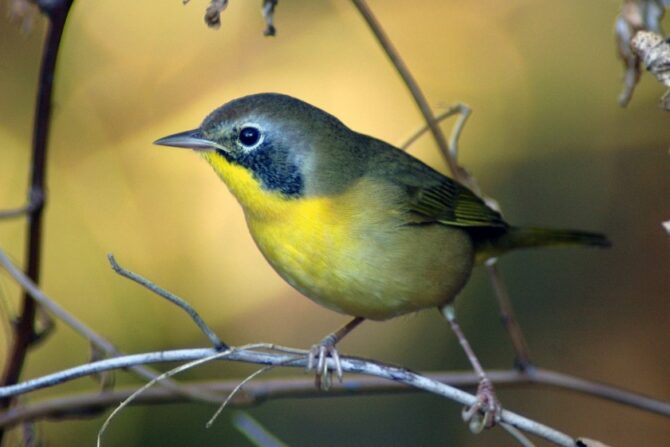
- Scientific Name: Setophaga americana
- Length: 4.3 to 4.9 inches
- Weight: 0.18 to 0.39 ounces
- Habitat: Forests
- Where Found: North America
- Conservation Status: Least Concern
The northern parula is a part of New World Warblers and is a native of North America.
It occurs in countries like Canada and the United States, where it inhabits different forms of forests.
There’s a tiny population that lives in western Europe, where it is a vagrant species.
The upper part of this bird is bluish-gray, but the underside is both yellow (on the breast) and white (on the belly).
Completing the physical traits are the white bars on the wings. Females have duller colors, but overall they are similar to males.
10. Western Kingbird
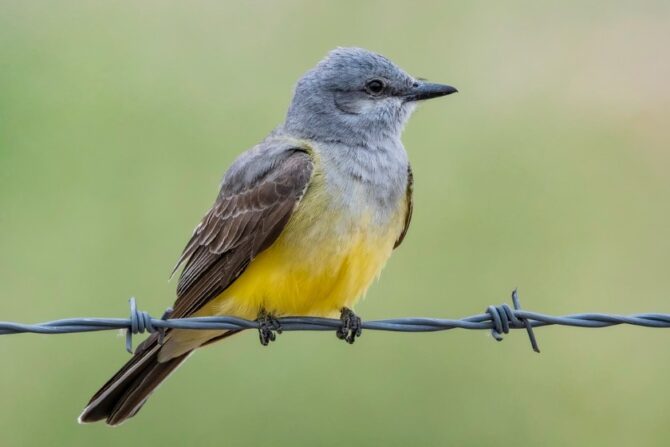
- Scientific Name: Tyrannus verticalis
- Length: 8 to 9.3 inches
- Weight: 1.4 ounces
- Habitat: Open areas
- Where Found: North America
- Conservation Status: Least Concern
The western kingbird is a member of the Tyrannidae family, the scientific name for tyrant flycatchers that live mainly in North and South America.
The western kingbird is a native of North America, reaching Mexico. It inhabits open areas.
The western kingbird is sometimes mistaken for some kingbird species, like the tropical kingbird or the Cassin’s kingbird.
However, there are noticeable differences. The western kingbird has a black tail that others don’t have. Other colors it has are gray and yellow.
11. Yellow-Headed Blackbird
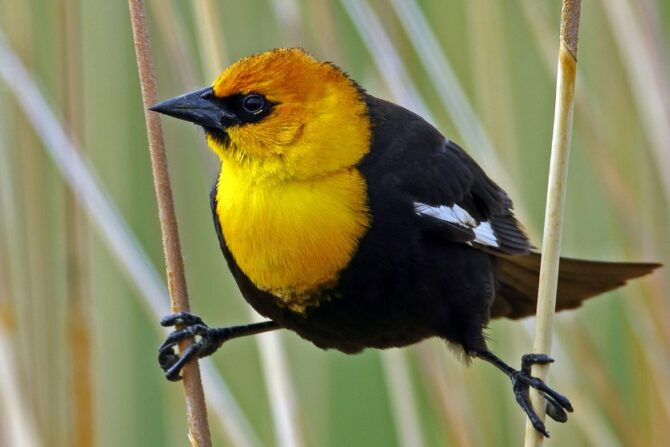
- Scientific Name: Xanthocephalus xanthocephalus
- Length: 8.3 to 10.2 inches
- Weight: 1.6 to 3.5 ounces
- Habitat: Marshes
- Where Found: North and Central America
- Conservation Status: Least Concern
The yellow-headed blackbird is a member of the family Icteridae, also known as the New World Blackbird.
It is found in North and Central America, living in places like Canada.
This bird is migratory, moving in huge flocks during the winter period. Its destination is usually the United States and Mexico.
The yellow-headed blackbird looks like its name suggests. Its upper parts are colored black, but the large head and breasts are yellow in color.
Females differ from males in that they are brown, and the yellow color is duller. On the female, this yellow appears on the breast and throat.
12. Canada Warbler
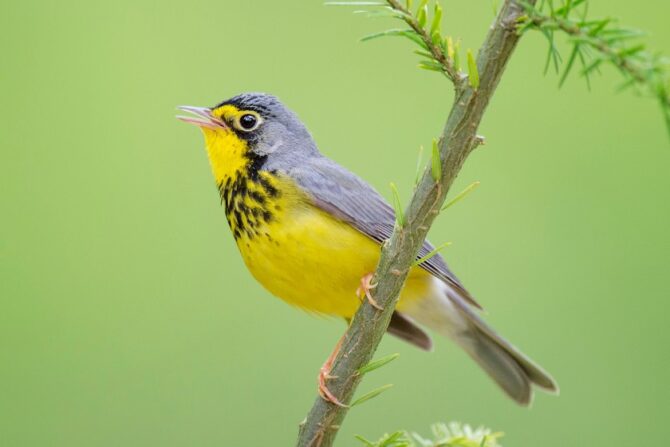
- Scientific Name: Cardellina canadensis
- Length: 4.7 to 5.9 inches
- Weight: 0.32 to 0.46 ounces
- Habitat: Moist thickets
- Where Found: North America, South America
- Conservation Status: Least Concern
The Canada warbler is a New World Warbler and a small songbird that stays in different parts of the Americas.
In the summer, you’d find it in North America, and in winter, it moves to South America.
The Canada warbler stays in moist thickets, and because its population is more in Canada, it was named the Canadian warbler.
A major physical identifier of the Canada warbler is the dark line around its chest that earned it the name “necklaced warbler.”
The upper parts are dark grey, but its belly, chest, and throat are yellow.
13. Blue-winged Warbler
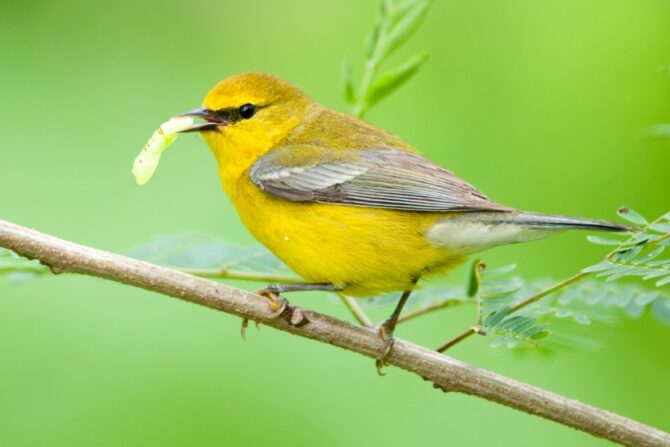
- Scientific Name: Vermivora cyanoptera
- Length: 4.5 inches
- Weight: 0.30 ounce
- Habitat: Fields
- Where Found: North America
- Conservation Status: Least Concern
The blue-winged warbler is quite common in its range because of how widespread it is. It is a native of North America, particularly in the United States.
There are very few of them living in western Europe as vagrants. The blue-winged warbler is often found in fields, especially ones with trees.
True to its name, this bird’s wings are colored blue, or, to be more precise, bluish gray.
The overall plumage is colored yellowish green, with the belly being yellow and the back green. The males are brighter than the females.
14. MacGillivray’s Warbler
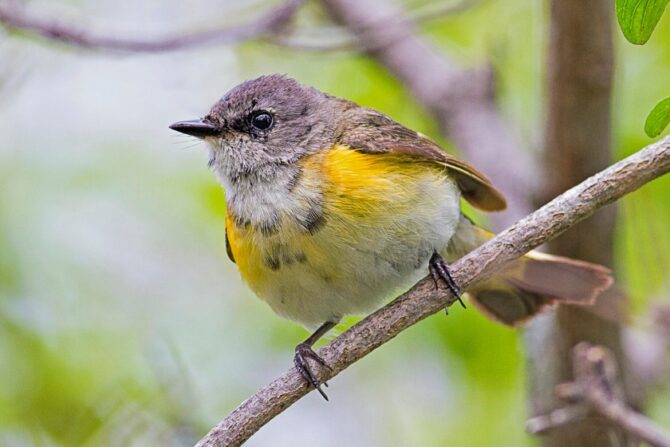
- Scientific Name: Geothylpis tolmiel
- Length: 3.9 to 5.9 inches
- Weight: 0.3 to 0.5 ounces
- Habitat: Dense thickets
- Where Found: North America
- Conservation Status: Least Concern
The MacGillivray’s warbler is part of the New World Warblers, but it differs slightly from others in its heaviness.
You’re more likely to find it on the ground than high up on trees. It is named in honor of an ornithologist named William MacGillivray.
It can be found in both the United States and Canada. During autumn, it migrates to Central America.
This bird’s overall plumage color is a yellowish green. The upper part of the adult is olive green, while the underside is yellow.
Males are slightly different from females in that they have blackheads, while females come with light gray heads.
15. Hooded Warbler

- Scientific Name: Setophaga citrina
- Length: 5.1 inches
- Weight: 0.32 to 0.42 ounce
- Habitat: Leafy woodlands
- Where Found: North America
- Conservation Status: Least Concern
The hooded warbler is a migratory bird that goes from its native North America to Central America during the winter period.
A few are also found as vagrants in Europe. This warbler’s preferred habitat are broadleaved woodlands.
The upper parts of the hooded warbler is colored olive green, but the underside is yellow.
In keeping with its name, this bird has a black hood on its face. Only males have this, though.
16. Mourning Warbler
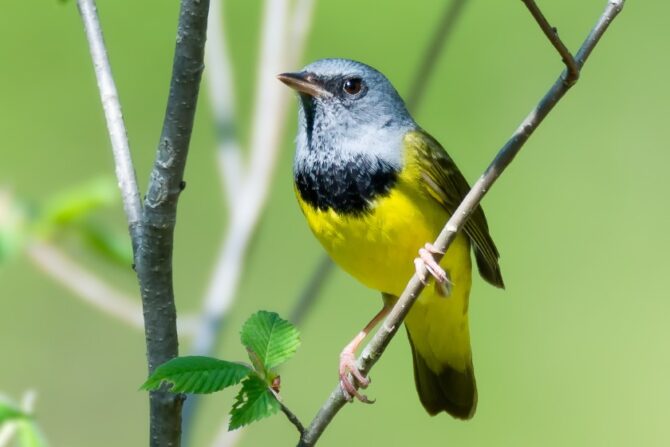
- Scientific Name: Geothylpis Philadelphia
- Length: 3.9 to 5.9 inches
- Weight: 0.4 to 0.5 pounds
- Habitat: Forests
- Where Found: North America
- Conservation Status: Least Concern
Similar to the hooded warbler, the male mourning warbler has a hood that looks like a mourning veil.
This is the inspiration for its name. This bird is a native of North America and can also be found in Central and South America as well.
It is migratory and moves within the Americas depending on the season.
The mourning warbler is often compared to the MacGillivray’s warbler in appearance, having the same olive green upper parts and a yellow underside.
17. Prothonotary Warbler

- Scientific Name: Protonotaria citrea
- Length: 5.1 inches
- Weight: 0.44 ounce
- Habitat: Hardwood swamps, Close to water bodies
- Where Found: North America
- Conservation Status: Least Concern
The prothonotary warbler is the only species in the Protonotaria genus, and its name is inspired by the plumage.
The color is likened to the robe once worn by papal clerks of the Roman Catholic church. These clerks were called prothonotaries.
This bird can be found in different areas of North America, but it migrates to the South and Central as well.
Its color combination is similar to most of the birds we’ve seen so far.
The upper part is olive green, while the underside is yellow. The head is also colored yellow. Females often have duller colors.
18. Pine Warbler
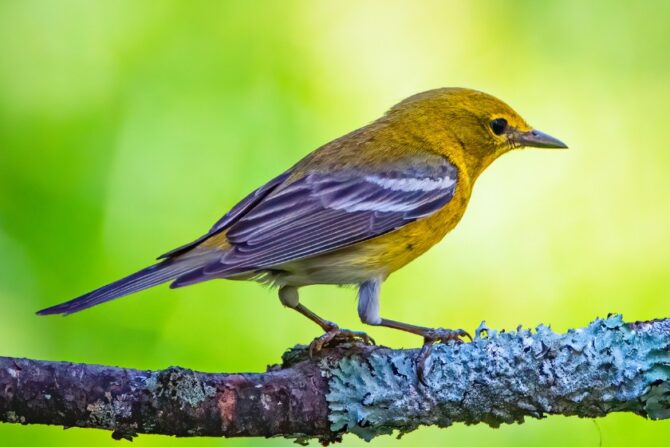
- Scientific Name: Setophaga pinus
- Length: 5 to 5.75 inches
- Weight: 0.42 ounce
- Habitat: Pine woods
- Where Found: North America
- Conservation Status: Least Concern
The pine warbler is a songbird that lives mainly in the eastern sides of North America.
Some of its population resides permanently in Florida, while others migrate to places like Mexico and the Caribbean.
As a songbird, the vocal sound this bird makes is a musical trill.
The pine warbler combines yellow, olive green, and white. Again, this is similar to some of the birds we’ve seen thus far.
The upper parts is colored olive green, but the throat and breast are yellow.
A physical trait that distinguishes the pine warbler from others on this list is the ‘spectacles’ around the eyes colored yellow.
19. Kentucky Warbler
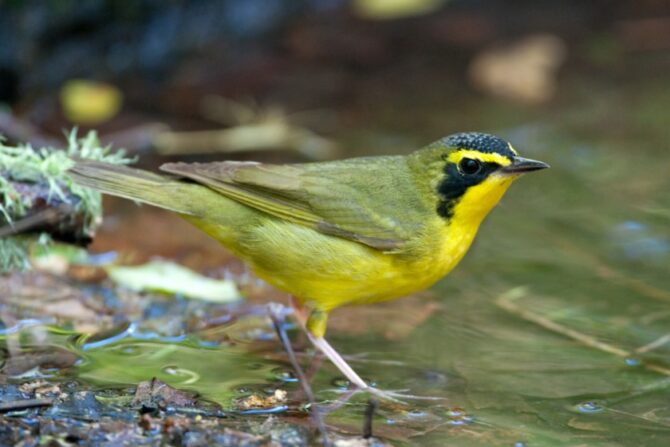
- Scientific Name: Geothylpis formosa
- Length: 5.1 inches
- Weight: 0.5 ounce
- Habitat: Hardwood forests
- Where Found: North America
- Conservation Status: Least Concern
The Kentucky warbler is an American small bird species that can be found in the United States in the summer.
During winter, it migrates, sometimes heading toward Mexico. Just like the MacGillivray warbler, this bird is heavy and often stays on the ground except when it wants to sing.
The Kentucky warbler is colored an olive green on its back and the nape of the neck, but from under the belly and up to the throat, it is colored yellow.
The eyes are encircled by a black mask with yellow patterns. On adult males, this mask is visible. Females have it less, and juveniles don’t often have any at all.
20. Lesser Goldfinch

- Scientific Name: Spinus psaltria
- Length: 3.5 to 4.7 inches
- Weight: 0.28 to 0.31 ounce
- Habitat: Places with trees and shrubs (except dense forests)
- Where Found: The Americas
- Conservation Status: Least Concern
The lesser goldfinch is classified under the goldfinch clade alongside the American goldfinch and Lawrence’s goldfinch, its relatives.
It is small and a songbird that occurs around the Americas.
Its preferred habitat is anywhere with trees and shrubs except for dense forests. It can also be found around humans.
The lesser goldfinch is the smallest finch in North America and possibly the smallest in the world.
Its back, wings, and the top of its head are black, though they can sometimes be green. Its underside is yellow, and there’s a white patch on the tail.
21. Lawrence’s Goldfinch
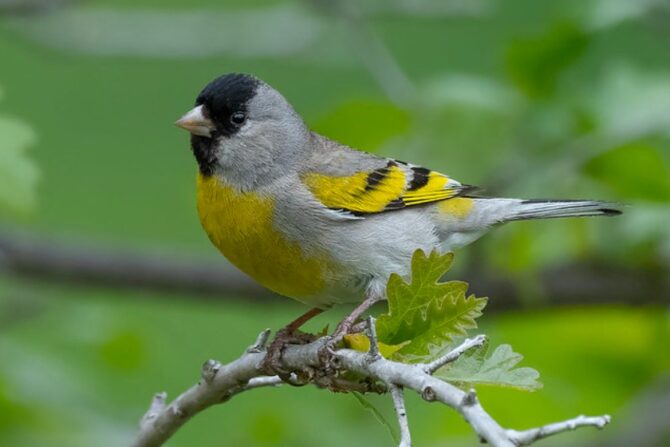
- Scientific Name: Spinus lawrencei
- Length: 4.75 inches
- Weight: 0.4 ounce
- Habitat: Dry and open woods
- Where Found: North America
- Conservation Status: Least Concern
Lawrence’s goldfinch has already been mentioned as a relative of the lesser goldfinch, and just like its clade member, it belongs to this list.
It is known to move around a lot but still stays within the North American range.
Where it chooses to stay depends on what food is available, as well as the climate.
Lawrence’s goldfinch is bigger than the lesser goldfinch but smaller than its other relative, the American goldfinch.
It has a lot of gray on its plumage, but the rump and part of its wings are yellow. The tail and head are black.
22. Kirtland’s Warbler
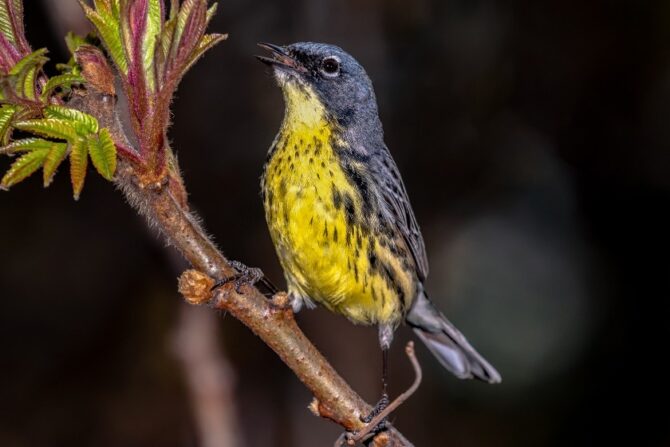
- Scientific Name: Setophaga kirtlandii
- Length: 5.5 to 5.9 inches
- Weight: 0.43 to 0.56 ounce
- Habitat: Young jack pine forests
- Where Found: North America
- Conservation Status: Near Threatened
The Kirtland’s warbler was named after a doctor and naturalist named Jared Potter Kirkland.
It is also known as the jack pine warbler or the jack pine bird. It is a small songbird found in the young jack pine forests (where it got its name).
It once was only limited to the United States and faced extinction 50 years back.
Thanks to conservation efforts, Kirtland’s warbler was restored and has expanded to other parts of the United States.
The upper body is bluish-grey with streaks at different sides. Its underside is yellow, going from the throat to the belly. It also has a white ring around the eye.
23. Cape May Warbler
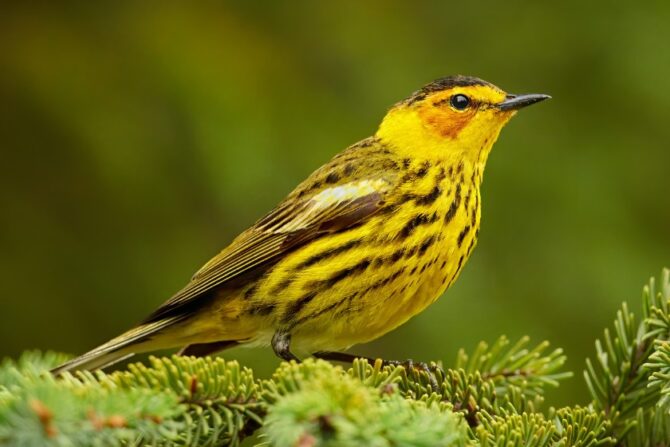
- Scientific Name: Setophaga tigrina
- Length: 4.7 to 5.5 inches
- Weight: 0.32 to 0.61 ounces
- Habitat: Spruce and balsam fir
- Where Found: North America
- Conservation Status: Least Concern
The Cape May warbler is named after Cape May, New Jersey, and it resides in North America. It stays in countries like Canada.
This bird is migratory and moves to the West Indies during the winter.
Males and females are slightly different. The male adult has a brown upper part, a yellow rump, and a crown that’s equally brown.
Females and younger ones have the same color pattern, but the colors look paler.
24. Yellow-throated Warbler
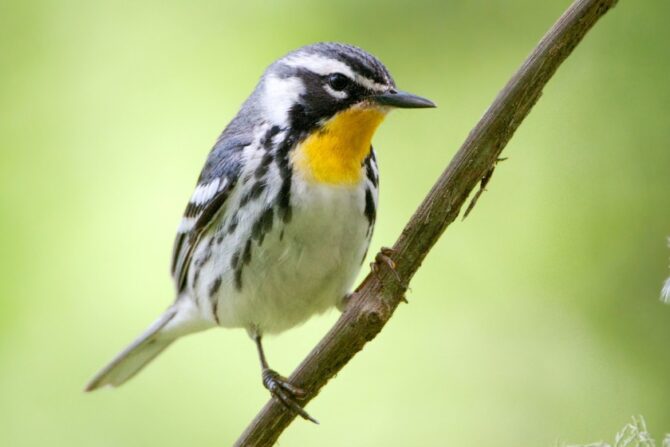
- Scientific Name: Setophaga dominica
- Length: 5.1 to 5.5 inches
- Weight: 0.3 to 0.4 ounce
- Habitat: Woodlands
- Where Found: North America
- Conservation Status: Least Concern
The yellow-throated warbler is a songbird staying in the Southeastern parts of North America.
Like the pine warbler, some individuals are non-migratory and reside in northwest Florida.
Others are migratory, moving towards Central America during the winter. A few can be found in South America, but they are vagrant species.
The bird is colored grey on the wings and back, while the underside is white.
The throat is the only part that’s colored yellow, which tallies with the name. Females and young ones are the paler versions of the adult male.
25. Townsend’s Warbler

- Scientific Name: Setophaga townsendii
- Length: 4.5 to 5 inches
- Weight: 0.31 ounce
- Habitat: Coniferous forests
- Where Found: North America
- Conservation Status: Least Concern
The Townsend’s warbler is a small songbird named after the American naturalist John Kirk Townsend, the man who formally described the bird.
It lives more on the coast of North America, opting for coniferous forests as its habitat.
Townsend’s warbler is migratory, and it spends winter in places like Mexico.
This bird has an olive upper part, but the stripes on the back differentiate it from other olive-colored birds on this list.
The same stripes appear on its yellow face, and its breast is yellow as well.
The belly goes in a different direction with its white color. Males have black masks, while females come with dark green ones.
26. Scott’s Oriole
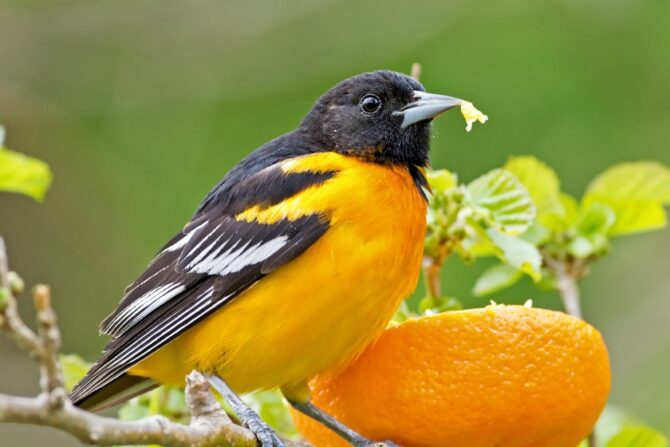
- Scientific Name: Icterus parisorum
- Length: 9.1 inches
- Weight: 1.1 to 1.4 ounces
- Habitat: Deserts
- Where Found: North America
- Conservation Status: Least Concern
The Scott’s oriole belongs to the New World Blackbird family known as the Icterid.
It was named after the American General Winfield Scott, though there have been calls for a change of name due to controversies.2
The Scott’s oriole lives mainly in the Southeastern parts of the United States. You can also find it in Mexico.
This bird is medium-sized. Its upper body is black with white stripes on the wings.
The underside is yellow, from the breast down to the belly. Completing its physical features are a black tail and a little beak.
27. Prairie Warbler
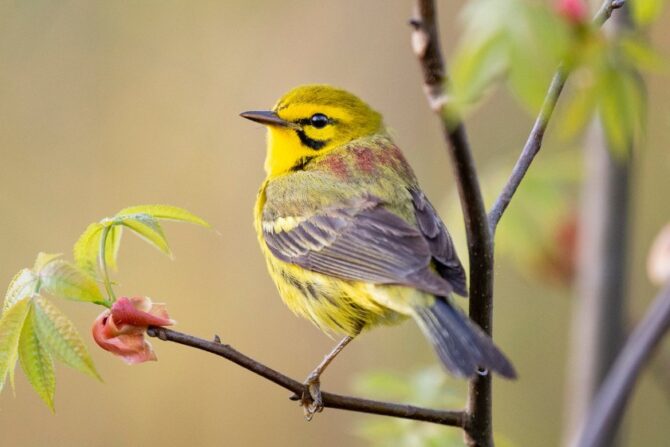
- Scientific Name: Setophaga discolor
- Length: 4.3 to 5.2 inches
- Weight: 0.27 ounce
- Habitat: Pine barren, cedar glades
- Where Found: North America
- Conservation Status: Least Concern
The prairie warbler lives in different parts of North America, living in places like Mexico and parts of the Caribbean.
Some are permanent residents, while others migrate. The prairie warbler is a songbird with two types of songs.
The first sounds like buzzy notes, while the second has a lower pitch.
This bird has an olive upper part with a yellow underside, and on each part, there are streaks.
The upper parts have rusty streaks, while the lower side is streaked dark.
28. Western Tanager
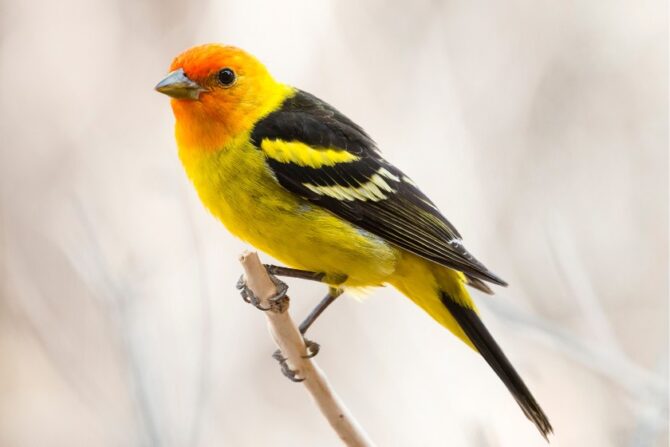
- Scientific Name: Piranga ludoviciana
- Length: 6.3 to 7.5 inches
- Weight: 0.8 to 1.3 ounces
- Habitat: Forests
- Where Found: North America
- Conservation Status: Least Concern
The Western tanager was once a part of the tanager family called Thraupidae, but more recent classifications has placed it in the Cardinalidae family alongside other members of its genus.
It still maintains the name, however. It was moved into the family of cardinals because of similarities in plumage and vocals.
The western tanager has a yellow underside, and this is the same amongst the sexes. However, there are some differences.
Males come with a red face, and all the upper part is black, from the wings to the tails.
Females have an olive back and yellow head; only the wings and tail are black.
29. Western Meadowlark
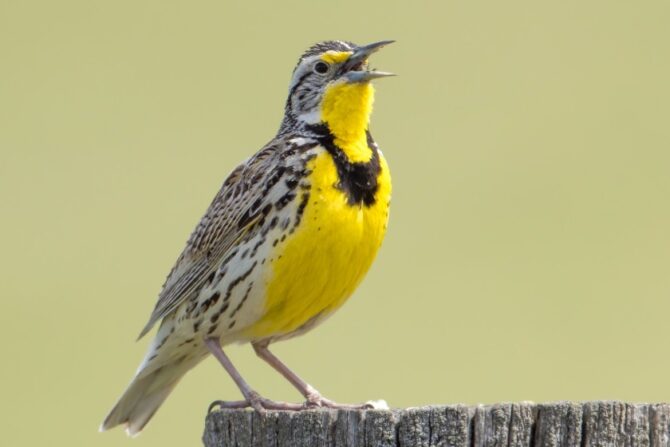
- Scientific Name: Sturnella neglecta
- Length: 8.5 inches
- Weight: 3.1 to 4.1 ounces
- Habitat: Grasslands, prairies, pastures
- Where Found: North America
- Conservation Status: Least Concern
The western meadowlark is a member of the Icteridae family, occurring across western and central North America.
Within its range, it inhabits various habitats like grasslands, prairies, and pastures.
The western meadowlark is well known and is the national bird of different states like Montana, Kansas, and Oregon.
The underside is a clear yellow, and there’s a black “V” inscribed on the western meadowlark’s breast.
The upper side is colored brown with black streaks, and there are stripes on its head.
30. Eastern Meadowlark

- Scientific Name: Sturnella magna
- Length: 7.5 to 11 inches
- Weight: 2.7 to 5.3 ounces
- Habitat: Grasslands, Prairies
- Where Found: Americas
- Conservation Status: Least Concern
The eastern meadowlark is similar to the western meadowlark. They belong to the same family and the same genus.
This species is spread throughout the Americas, ranging from the North to the South.
Preferred habitats include prairies, grasslands, and hay fields.
Just like the western meadowlark, its sister species has a yellow underside with a V on the breast.
The upper parts are usually brown with streaks of black, and the head is painted brown as well.
31. Audubon’s Oriole
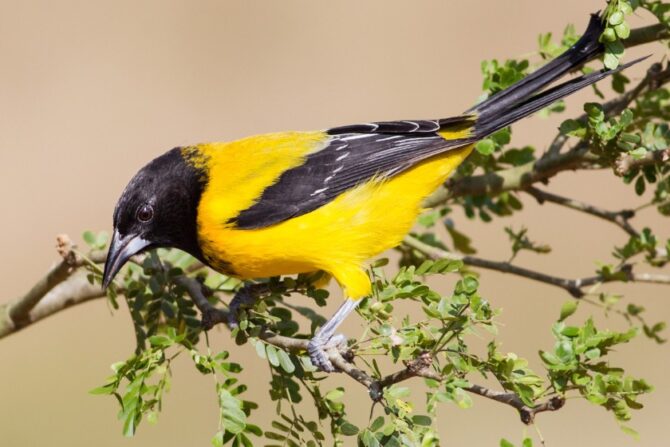
- Scientific Name: Icterus graduacauda
- Length: 7.5 to 9.4 inches
- Weight: 1.1 to 1.9 ounces
- Habitat: Forests
- Where Found: North America
- Conservation Status: Least Concern
The Audubon’s oriole was once known as the black-headed oriole, and it is a member of the Icteridae family.
It lives in Texas and Mexico, staying in forests. It can especially be found close to the riverside. This species can be divided into four subspecies.
The Audubon’s oriole is the only bird that has a black hood and a predominant yellow plumage.
Its tail and wings are also black, matching the hood on its head.
Related: Check Out These Amazing Yellow Animals
Wrap Up
The different types of yellow birds are fanciful to view, whether the color is predominant or is on only one part of the bird’s plumage.
Because yellow is often associated with happiness, sighting a bird with this color is enough to brighten up your mood.
The best part is most of these birds can easily be seen in the United States.
References & Notes
- Vagrant Birds: What’s That? Kellogg Bird Sanctuary.
- What’s In a Bird Name? Audubon.
